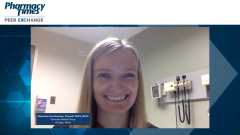
Optimizing Care for Patients With Heart Failure
Key opinion leaders in the pharmacologic management of heart failure share insights on optimizing care by using a patient-centered approach and shared decision-making.
Episodes in this series

Richard Mullvain, RPh, BCCP, BCPS, CCCC: We’ve talked about getting patients on the medications, but that’s not enough. We need to optimize their medications. I’m going to shift the question to Alex first and then Ryan. How do you approach medication optimization in a patient with heart failure? Why don’t you start us out, Alex?
Alexandra Goncharenko, PharmD, BCPS, BCCP: Sure. I approach it by following the guideline recommendations in initiating the doses. The 2021 guideline update we’ve been talking about has very nice tables, figures, and pathways for reference. What doses should we start with? What doses do we need to titrate to? It can be very complex. Patients can have adverse effects or cost issues, so knowing how to switch between is important. Many patients are hesitant, so continual education is important. When you’re adding another medication, they think, “Aren’t we stopping the other 1?” Continuing that education on both the pathophysiology of heart failure and the importance of these medications is very important to not just improve symptoms but save their life. Those are some of the things I use to ensure appropriate adherence and continue to optimize the medicines at every visit.
Richard Mullvain, RPh, BCCP, BCPS, CCCC: That was great, Alex. Ryan, do you have anything to add to that regarding optimizing medications for heart failure?
Ryan Jacobsen, PharmD, BCPS: Yes. I’m going to use a bit of a buzzword in terms of my approach. That involves patient-centered care. That seems to be the buzzword in health care the last few years. We’re transitioning from a provider-centric model—in which patients are diagnosed with a condition, given a prescription, and told to go home, take it, and come back in 6 months—to a model of care that really focuses on the patient and views each unique patient for who they are, involves shared decision-making, and takes into account the whole patient. We know that we have high-quality evidence. We have a great ACC [American College of Cardiology] Expert Consensus Decision Pathway to guide prescribing. But until we really make a connection with that patient, provide the education that Alex mentioned, address those barriers to adherence that Randy commented on, only then can we start to truly achieve saving a patient’s life and maintaining their quality of life in the process.
These medication regimens are complex, so education and setting expectations with patients that we’re going to start you on a number of medications is important. If you go home, and you’re not certain with it, we want you to call. We can’t help you unless we communicate, and we want to keep those channels of communication open. Speak to your community pharmacist. We’re all part of your care team, and we want to help you achieve those goals of care together.
Richard Mullvain, RPh, BCCP, BCPS, CCCC: Very good, Ryan. Thank you. We’ve covered a little of this, but I want to make sure we have a real handle on this. We’ve talked about the new therapies out there, but what are some of the challenges when initiating these new therapies for our patients with heart failure? There are comorbidities like CKD [chronic kidney disease], hypertension, and angioedema, as well as cost. I’ll start with Alex on this 1 as well.
Alexandra Goncharenko, PharmD, BCPS, BCCP: In general, guideline-directed medical therapy is very well tolerated. Initially, patients come in feeling those heart failure symptoms. I tell patients, “It’s not overnight, but you will notice that you will slowly and surely start to feel improvement.” Most patients experience significant improvement in their symptoms after initiation of these medications. It’s important to tell them it’s not going to be overnight, and hopefully establish that patient-provider relationship where they communicate those things with you.
Simultaneous initiation and continuation of medications can also help improve the tolerance and adherence of therapies. For example, SGLT2 inhibitors are renal protective. If we get those on, we can increase the use and tolerance of spironolactone, eplerenone, and the ARNIs [angiotensin receptor neprilysin inhibitors]. It’s important to be familiar with each drug class, knowing that SGLT2 inhibitors, or even some of the RAS inhibitors, can cause temporary fluctuations in renal functional laboratory markers. But those are temporary. The long-term benefits outweigh the risk of that.
Patients who have more advanced disease and are heading toward stage D heart failure may not tolerate maximal doses, or even those 4 therapies. This is a red flag. It should be discussed with the patient. Also, encourage the patient to seek consultation, perhaps with their general cardiologist, who may be able to screen them for other causes of heart failure or even transition them to a more advanced heart failure center for evaluation for LVAD [left ventricular assist device] and transplant, or even hospice or palliative care if appropriate.
Richard Mullvain, RPh, BCCP, BCPS, CCCC: Great point. Thank you.
Transcript edited for clarity.
Newsletter
Stay informed on drug updates, treatment guidelines, and pharmacy practice trends—subscribe to Pharmacy Times for weekly clinical insights.
















































































































































































































